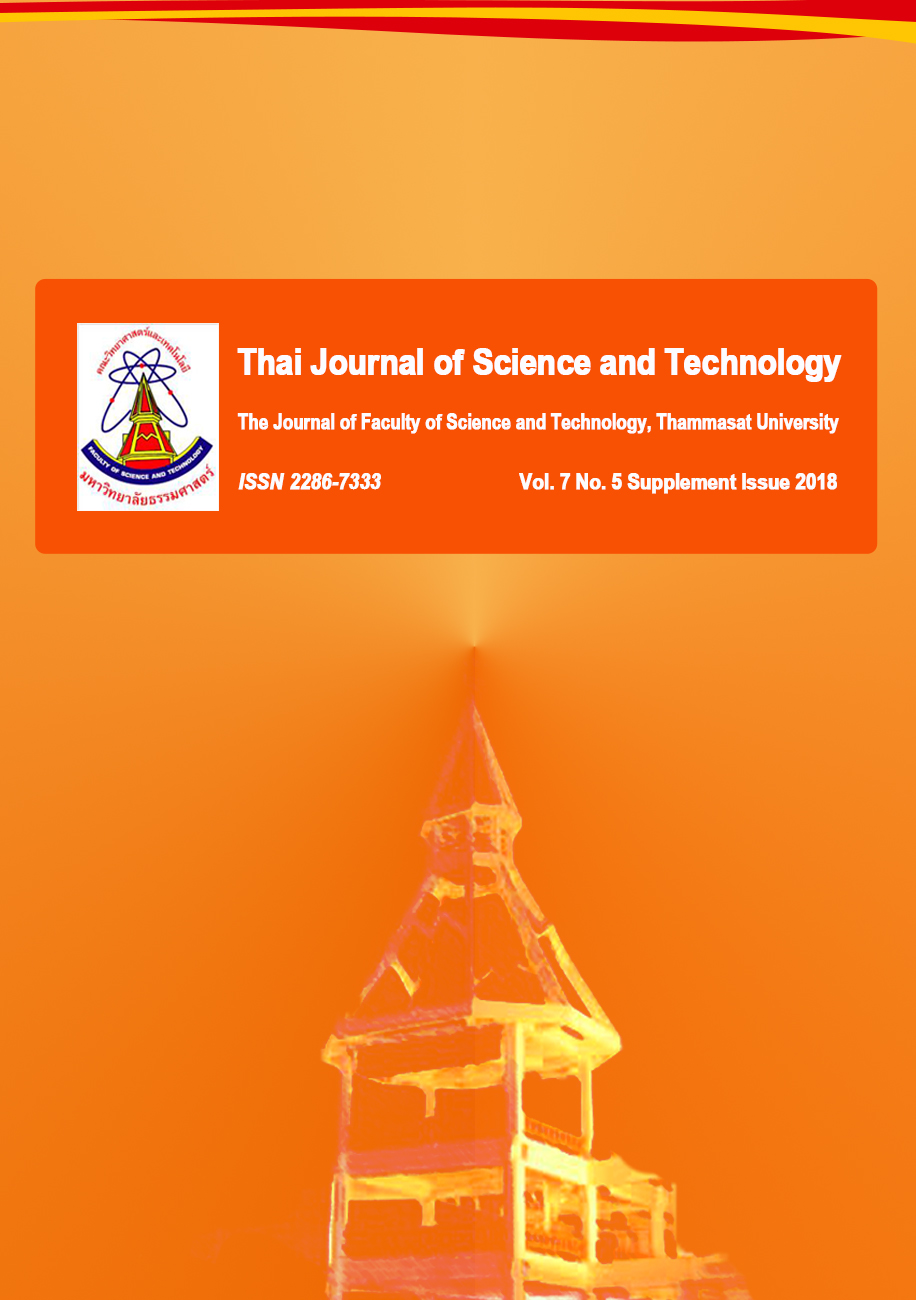การหาสภาวะที่เหมาะสมในการสกัดเพกทินจากเปลือกกล้วยหอมทองด้วยกรดไฮโดรคลอริกและกรดซิตริก
Main Article Content
Abstract
Abstract
Banana (Musa acuminata, AAA group, cultivar ‘Hom Thong’) is one of the most economically important fruit of Thailand. Banana peels represent 30 % of the total weight of fresh banana and the large amount of these peels possesses environmental problem. This research focused on the potential of ‘Hom Thong’ banana peel to be a source of pectin. Effects of acids (hydrochloric acid and citric acid), extraction temperature (85-95 ºC), time (60-180 min) and pH (1.0-3.0) on yield and methoxyl content of extracted pectin were determined using central composite design (CCD). It was found that citric acid was more effective in pectin extraction than hydrochloric acid. Extracted pectin from banana peels with citric acid showed a good physical property and had a high yield. High methoxyl pectin (HMP) and low methoxyl pectin (LMP) were obtained when the peels were extracted by hydrochloric acid and citric acid, respectively. The extraction pH was the main factor affecting yield and methoxyl content of pectin. Furthermore, higher temperatures and times could enhance pectin yield and methoxyl content. By considering yield and methoxyl content, the use of hydrochloric acid at 90 ºC, pH 2.03 with an extraction time of 130 min was the optimal condition for HMP extraction. The yield and methoxyl content under this condition were 14.04 and 9.24 %, respectively. The optimal condition which produced LMP with maximum value of yield and methoxyl content was the use of citric acid at 93 ºC, pH 3.0 with an extraction time of 150 min (16.61 and 6.09 %, respectively).
Keywords: ‘Hom Thong’ banana; pectin extraction; optimal condition; yield; methoxyl content
Article Details
บทความที่ได้รับการตีพิมพ์เป็นลิขสิทธิ์ของคณะวิทยาศาสตร์และเทคโนโลยี มหาวิทยาลัยธรรมศาสตร์ ข้อความที่ปรากฏในแต่ละเรื่องของวารสารเล่มนี้เป็นเพียงความเห็นส่วนตัวของผู้เขียน ไม่มีความเกี่ยวข้องกับคณะวิทยาศาสตร์และเทคโนโลยี หรือคณาจารย์ท่านอื่นในมหาวิทยาลัยธรรมศาสตร์ ผู้เขียนต้องยืนยันว่าความรับผิดชอบต่อทุกข้อความที่นำเสนอไว้ในบทความของตน หากมีข้อผิดพลาดหรือความไม่ถูกต้องใด ๆ
References
ณรงค์ ศิริรัมย์ และเมธินี เห่วซึ่งเจริญ, 2548, การสกัดและสมบัติของเพกทินจากกากฝรั่งพันธุ์กลมสาลี่, วิทยานิพนธ์ปริญญาโท, มหาวิทยาลัยเชียงใหม่, เชียงใหม่.
ธานุวัฒน์ ลาภตันศุภผล, ปฏิมา ทองขวัญ และศิริลักษณ์ สรงพรมทิพย์, 2556, การสกัดเพคตินจากเปลือกผักและผลไม้, ว.วิทยาศาสตร์เกษตร 44(2)(พิเศษ): 433-436.
พวงทอง ใจสันติ์, จิตรา กลิ่นหอม และอัจฉรา เทียมภักดี, 2541, การทดสอบการใช้เพกทินที่สกัดได้จากเปลือกเสาวรสในการผลิตแยม, รายงานการวิจัย, มหาวิทยาลัยเชียงใหม่, เชียงใหม่.
ศิวะเทพ เรืองพรหม และกิตติชัย บรรจง, 2557, การเปรียบเทียบคุณลักษณะและผลผลิตของเพกตินจากเปลือกตาลดิบที่ใช้แอลกอฮอล์นำกลับมาใช้ใหม่ทดแทนเอธิลแอกอฮอล์ 95% ในขั้นตอนการตกตะกอนและการล้าง, ว.เกษตรพระจอมเกล้า 32(1): 50-58.
สำนักงานเศรษฐกิจการเกษตร, 2559, สารสนเทศเศรษฐกิจการเกษตรรายสินค้า, เอกสารสถิติการเกษตร เลขที่ 402, กระทรวงเกษตรและสหกรณ์, กรุงเทพฯ, 111 น.
Castillo-Israel, K.A.T., Baguio, S.F., Diasanta, M.D.B., Lizardo, R.C.M., Dizon, E.I. and Mejico, M.I.F., 2015, Extraction and characterization of pectin from Saba banana [Musa ‘saba’ (Musa acuminate x Musa balbisiana)] peel wastes: A preliminary study, Food Res. Int. 22: 202-207.
Gonzalez-Montelongo, R., Lobo, M.G. and Gonzalez, M., 2010, Antioxidant activity in banana peel extracts: Testing extraction conditions and related bioactive compounds, Food Chem. 119: 1030-1039.
Happi Emaga, T., Ronkart, S.N., Robert, C., Wathelet, B. and Paquot, M., 2008, Characterisation of pectins extracted from banana peels (Musa AAA) under different conditions using an experimental design, Food Chem. 108: 463-471.
Jafari, F., Khodaiyen, F., Kiani, H., and Hosseini, S.S., 2017, Pectin from carrot pomace: optimization of extraction and physicochemical properties, Carbohydr. Polymers 157: 1315-1322.
Kliemann, E., Nunes de Simas, K., Amante, E.R., Prudencio, E.S., Teofilo, R.F., Ferreira, M.M.C. and Amboni, R.D.M.C., 2009, Optimisation of pectin acid extraction from passion fruit peel (Passiflora edulis flavicarpa) using response surface methodology, Int. J. Food Sci. Technol. 44: 476-483.
Lofgren, C. and Hermansson, A.M., 2007, Synergistic rheological behavior of mixed HM/LM pectin gels, Food Hydrocoll. 21: 480-486.
Oliveira, T.I.S., Rosa, M.F., Cavalcante, F.L., Pereira, P.H.F., Moates, G.K., Wellner, N., Mazzetto, S.E., Waldron, K.W. and Azeredo, H.M.C., 2016, Optimization of pectin extraction from banana peels with citric acid by using response surface methodology, Food Chem. 198: 113-118.
Pereira, P.H.F., Oliveira, T.I.S., Rosa, M.F., Cavalcante, F.L., Moates, G.K., Wellner, N. and Waldron, K.W., 2016, Pectin extraction from pomegranate peels with citric acid, Int. J. Biol. Macromol. 88: 373-379.
Raji, Z., Khodaiyan, F., Rezaei, K., Kiani, H. and Hosseini, S.S., 2017, Extraction optimization and physicochemical properties of pectin from melon peel, Int. J. Biol. Macromol. 98: 709-716.
Schemin, M.H.C., Fertonani, H.C.R., Waszczynskyj, N. and Wosiacki, G., 2005, Extraction of pectin from apple pomace, Braz. Arch. Biol. Technol. 48: 259-266.
Virk, B.S. and Sogi, D.S., 2004, Extraction and characterization of pectin from apple pomace (Malus pumila Cv Amari) peel waste, Int. J. Food Prop. 7: 1-11.
Woo, K.K., Chong, Y.Y., Li Hiong, S.K. and Tang, P.Y., 2010, Pectin extraction and characterization from red dragon fruit (Hylocereus polyrizus): A preliminary study, J. Biol. Sci. 10(7): 631-636.


